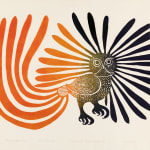-
Artworks
KENOJUAK ASHEVAK, C.C., R.C.A. (1927-2013) KINNGAIT (CAPE DORSET)
The Enchanted Owl, 1960 #24Printmaker: EEGYVUDLUK POOTOOGOOK (1931-1999) KINNGAIT (CAPE DORSET)
Cutter or Plate maker: IYOLA KINGWATSIAK (1933-2000) KINNGAIT (CAPE DORSET)
stonecut, 20.5 x 26 in (52.1 x 66 cm)
5/50Lot 11
ESTIMATE: $150,000 — $250,000
PRICE REALIZED: $168,000.00Further images
Kenojuak Ashevak’s artistic process, as described in a 1980 interview with Jean Blodgett, was a study in intuitive creation. She would commence each piece as a 'statement,' building upon it...Kenojuak Ashevak’s artistic process, as described in a 1980 interview with Jean Blodgett, was a study in intuitive creation. She would commence each piece as a "statement," building upon it with meticulous attention until reaching what she deemed the artwork's natural conclusion. [1] Her early works in graphite reveal a close association with the patterns that she made to use in her sewing of clothing, dolls, and sealskin bags. This approach yielded complex, striking scenes of meandering fantasia, such as Rabbit Eating Seaweed and Dog Sees the Spirits (see Lots 87 and 122, respectively). Kenojuak’s artistic curiosity and skill quickly pushed her to explore different imagery. Vastly different from her earlier silhouette aesthetic, in 1960 she offered to James Houston a graphite drawing that was a decisive, striking visual proclamation. The Enchanted Owl offers a singular view of the clever creature, defined by a wise gaze that penetrates the viewer’s nerve of being. With long fanciful plumes, the owl stands solitary against the void of the white sheet, blazing forth like an emblem.
Like several other prints of this period, The Enchanted Owl was issued in two colour schemes: an initial batch of 25 prints featuring red and black, followed by another 25 in green and black, known colloquially as "red-tail" and "green-tail." Though each subset shares the same colour scheme, the individual prints differ substantially due to variations in ink intensity, roller reach, and overlap in colours. In his 2011 publication Inuit Prints: Japanese Inspiration, Norman Vorano specifically highlighted The Enchanted Owl as the first Inuit print where colours flowed freely, unbound by form. [2] For the graphic, printmaker Eegyvudluk Pootoogook approached Iyola Kingwatsiak’s carved block as if it were an open palette, applying the black and the red or green colours without constraint to the contours of the stone support.
The synergy of these various components – Kenojuak’s crisp confident lines and fluid forms, Iyola’s masterful translation of the image into stone relief, and Eegyvudluk ’s impeccable inking – combined like alchemy to forge an image that now holds preeminent status in Inuit graphic art. All this shines forth in the stunning early impression of the print that you see before you.
Upon its release, the print immediately captured attention with its bold, central imagery; it was reproduced in no less than a dozen contemporary newspaper and magazine articles. Carl Weiselberger of the Ottawa Citizen wrote after the opening of the print exhibition on Parliament Hill, “But that magnificent stone cut of an Enchanted Owl by the woman artist, Kenojuak [...] has a touch of the fantastic palette of modern European Expressionists like Kubin or Klee.” [3] Another contemporaneous article called Kenojuak “The Poet of the Arctic,” describing that she was “a designer of exceptional power and her art is comparable in rhythmic energy to that of the late Emily Carr. Her best pieces could hang in honor in any display of international printmaking.” [4]
The enduring Modernist graphic appeal of The Enchanted Owl remains undiminished to this day. Its visual allure extends far beyond its original medium; the image has graced Canadian postage stamps, seminal book covers, and a myriad of other platforms including numerous publications, posters, mugs, scarves, and postcards. Beyond its place as the most renowned representation of Inuit art, The Enchanted Owl has reached a virtually unparalleled level of iconic status in not just Canadian art but in the broader tapestry of global visual expression.
1. Jean Blodgett, Kenojuak, 1985, p. 38.
2. Norman Vorano, Inuit Prints: Japanese Inspiration, 2011, p. 57.
3. Ottawa Citizen, 1 March 1961, p. 15.
4. Calgary Herald, 23 September 1961, p. 5.References: See Jean Blodgett, Kenojuak, (Toronto: Firefly Books / Mintmark Press Ltd., 1985), fig. xvi, p. 57, for the original graphite drawing and print. Article and Magazines that reproduced The Enchanted Owl contemporaneously to its purchase availability include but are not limited to: “Poetess of the Arctic,” The Kingston Whig-Standard, 24 July 1961, p. 7; Lloyd Stewart, “Carlin Galleries Open Eskimo Art Exhibition,” Fort Worth Star-Telegram, Texas, USA, 22 July 1961, p. 14; Pearl McCarthy, ”Cape Dorset Eskimo Community Is First to Employ White Adviser,” Globe and Mail, 7 Aug 1961, p. 13; “Kenojuak-Poet of the Arctic,” Toronto Daily Star, 8 August 1961, p. 28; “Poet of the Arctic,” Calgary Herald, 23 September 1961, p. 5; Kenneth Saltmarche, “Eskimo Art Coming to Gallery,” Windsor Star, 25 February 1961; Carl Weiselberger, “Stone-Cut and Seal Skin Art,” Ottawa Citizen, 1 March 1961, p. 15.
Provenance
Collection of Ann Landers (the famous internationally syndicated advice columnist), San Francisco;
Butterfields Auctions, San Francisco, November 2002;
Collection of John and Joyce Price, Seattle.
Join our mailing list
* denotes required fields
We will process the personal data you have supplied in accordance with our privacy policy (available on request). You can unsubscribe or change your preferences at any time by clicking the link in our emails.


